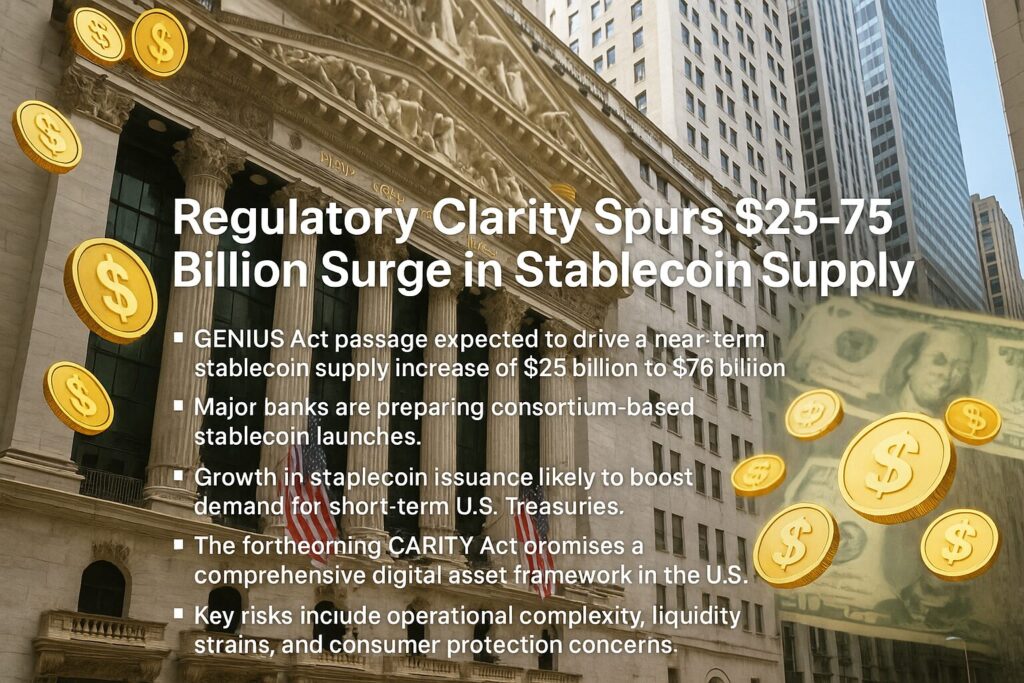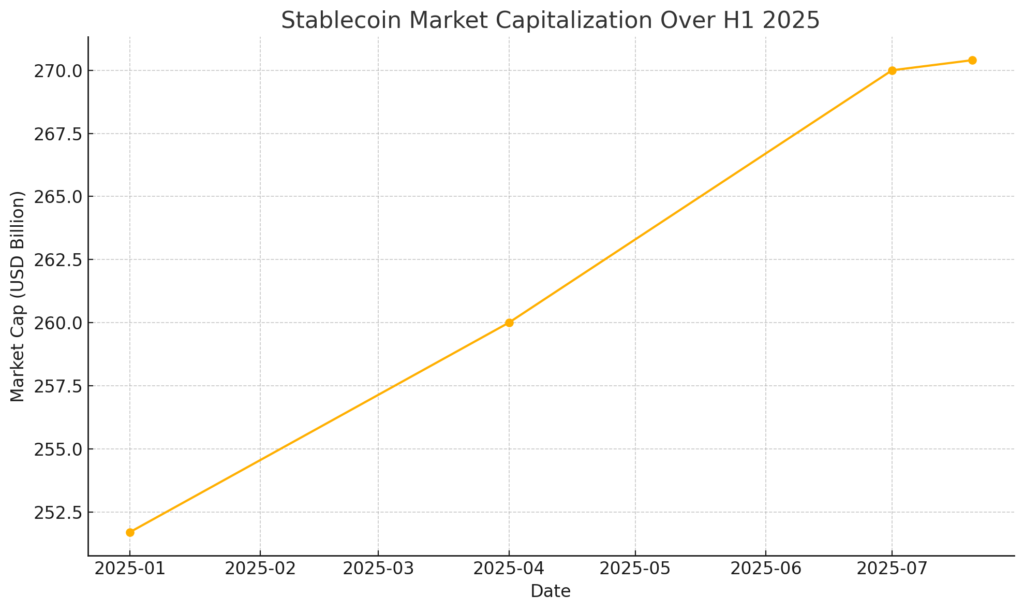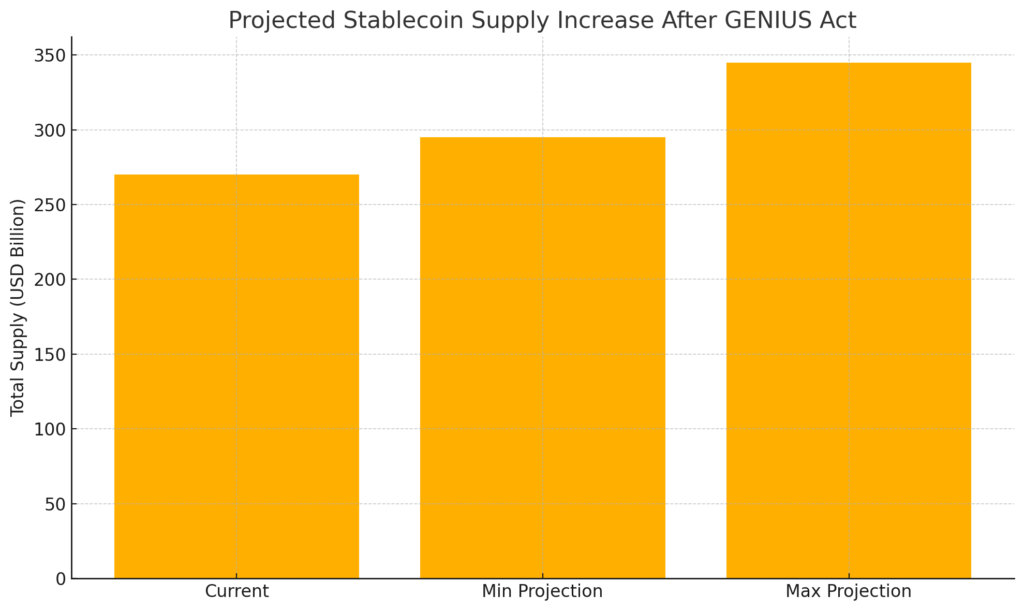
Main Points:
- GENIUS Act passage expected to drive a near‑term stablecoin supply increase of $25 billion to $75 billion.
- Total stablecoin market capitalization stands at $270.4 billion as of July 20, 2025.
- Major banks are preparing consortium-based stablecoin launches.
- Growth in stablecoin issuance likely to boost demand for short-term U.S. Treasuries.
- The forthcoming CLARITY Act promises a comprehensive digital asset framework in the U.S.
- Key risks include operational complexity, liquidity strains, and consumer protection concerns.
1. GENIUS Act: A Watershed Moment for Stablecoin Regulation
On July 18, 2025, President Trump signed the GENIUS Act into law, establishing the first unified federal framework for payment stablecoins. By mandating one‑to‑one high‑quality asset reserves and clear licensing under the Office of the Comptroller of the Currency, the Act removes longstanding regulatory ambiguities that previously hampered institutional entry into the stablecoin market. Bank of America analysts describe this legislative milestone as the catalyst for an immediate uptick in issuance, estimating a near‑term supply expansion of $25 billion to $75 billion.
This infusion of clarity is poised to accelerate the development of infrastructure—the rails for minting, redeeming, and auditing stablecoins—while enabling tokenized banking products to flourish. The Act’s explicit permission for banks to issue stablecoins underscores a strategic pivot toward integrating digital assets into traditional financial services.
2. Current Market Landscape: $270 Billion and Rising
According to CoinMarketCap, the total stablecoin market capitalization reached $270.4 billion on July 20, 2025—up from approximately $251.7 billion at the start of the year. This growth reflects both robust demand for programmable money in DeFi and broader adoption by corporate treasuries.
<Figure 1: Stablecoin Market Capitalization Over H1 2025 (USD Billion). >

3. Institutional Adoption: Consortium Models Take Shape
Bank of America’s report highlights that major banks are finalizing preparations to issue stablecoins, favoring consortium-based approaches that pool resources, share infrastructure costs, and mitigate individual counterparty risks. This collaborative model is expected to feature:
- Shared governance and standards for reserve auditing.
- Interoperability across issuing banks to streamline redemption.
- Joint KYC/AML frameworks to meet enhanced regulatory scrutiny.
Bank CEOs—including BofA’s Brian Moynihan—have publicly confirmed groundwork completion, signaling that the sector is “ready to move” when market conditions align.
4. Macro Impacts: U.S. Treasury Demand and Liquidity Considerations
As stablecoin reserves must be backed by high-grade assets, the anticipated supply surge may translate into increased demand for short-term U.S. Treasuries. BofA projects that stablecoin issuers will allocate a significant portion of new reserves to Treasury bills, potentially influencing Treasury issuance strategies and short-term funding costs.
However, this dynamic carries risks:
- Liquidity strain if issuers cannot rotate reserves quickly.
- Operational complexity in managing rapid reserve flows.
- Market concentration if a few banks dominate issuance.
5. Looking Ahead: The CLARITY Act and Broader Adoption
While the GENIUS Act addresses stablecoin-specific regulations, the CLARITY Act—passed by the House on July 17, 2025—aims to categorize digital assets clearly as commodities or securities and resolve SEC/CFTC jurisdictional overlap. As the Senate considers a streamlined market‑structure draft, reconciliation between the two versions will be critical to providing a holistic framework for tokenized finance.
Key provisions include:
- Token “graduation” mechanisms for issuers to exit SEC oversight via certification.
- Biannual disclosure requirements on issuer operations, ownership, and reserve compositions.
- Guidance for new token launches, reducing legal uncertainty for innovators.
<Figure 2: Projected Stablecoin Supply Increase After GENIUS Act (USD Billion). >

Conclusion
The passage of the GENIUS Act marks a pivotal turning point for stablecoins, unleashing a projected $25 billion to $75 billion supply increase and laying the groundwork for institutional digital asset issuance. With a total market capitalization surpassing $270 billion and banks rallying around consortium models, the near-term outlook is bullish. Yet, sustaining this momentum will require careful management of reserve liquidity, rigorous consumer protections, and the complementary CLARITY Act to embed digital assets firmly within the U.S. financial regulatory ecosystem.

